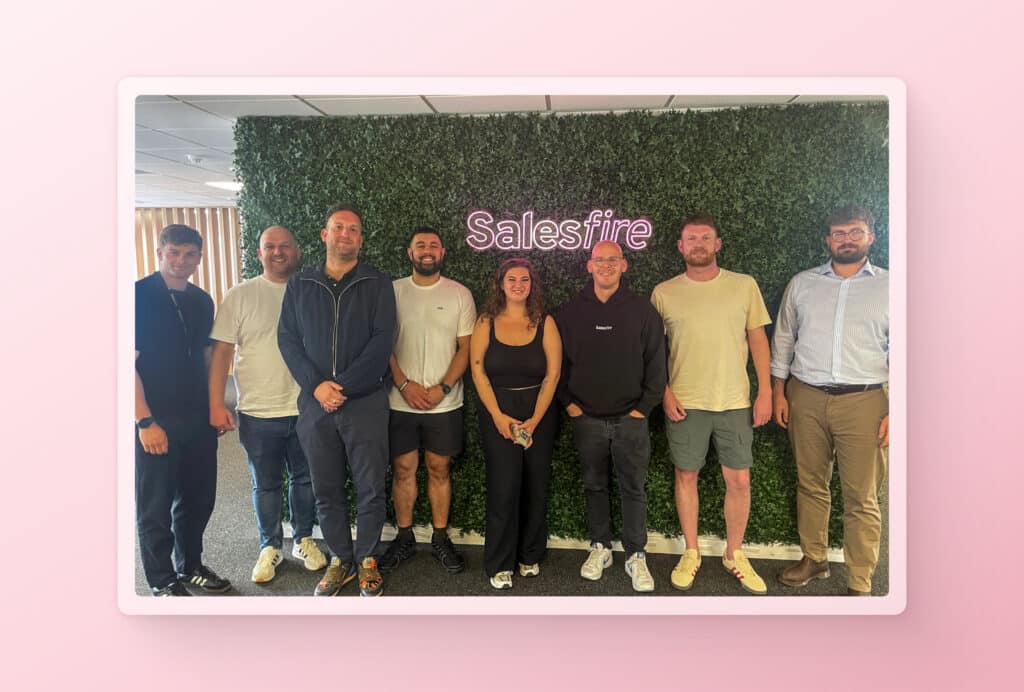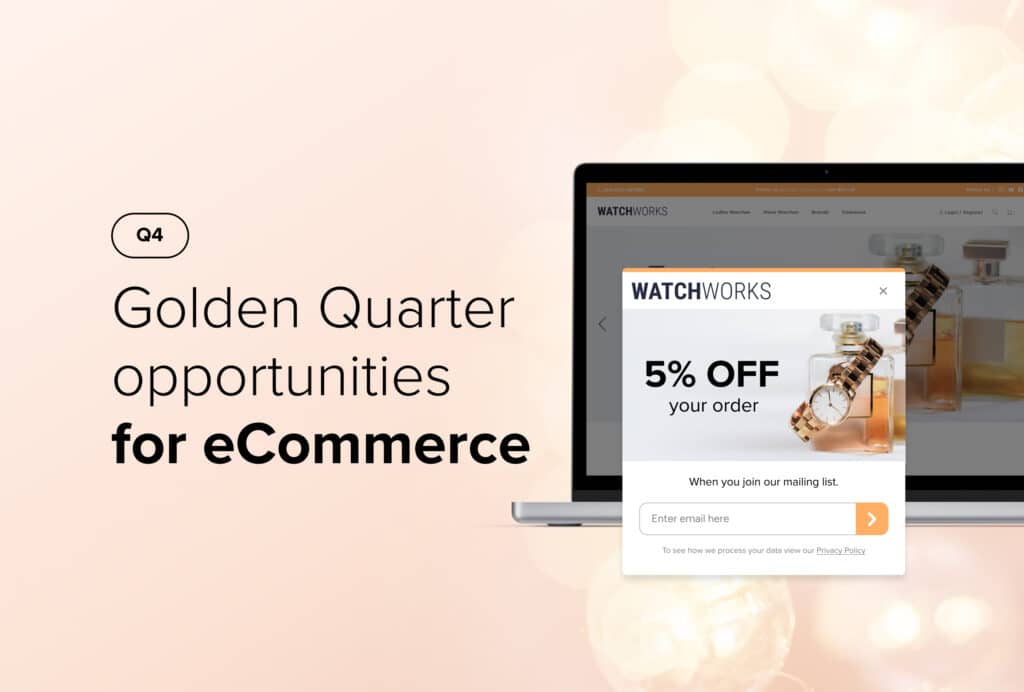The Year the World Turned Digital: A Trends Webinar
By Laura Taylor • Last updated: Friday Aug 9th, 2024

We kicked off 2021 with our very first Trends webinar – The Year the World Turned Digital.
It’s fair to say that everyone is relieved to leave 2020 behind, and whilst the past year has been far from usual, it has provided us with an opportunity to delve into the trends that kept the world spinning.
In our Trends discussion, Salesfire’s head of marketing, Josh McGregor, and marketing strategist, Calum Ridley, uncovered the data from 2020’s eCommerce rollercoaster, discovered which trends are here to stay and discussed how to apply the key findings to your 2021 marketing strategy.
If you missed it, here’s a live recording of the full session complete with a transcript below.
Josh: [00:00:00] Good morning everyone and a massive thank you to everybody brave enough to join us on revisiting a year so crazy that they named it twice. 2020. If you didn’t get that.
Your guides today are going to be me, Josh McGregor, head of marketing here at Salesfire, but I’d also like to introduce Calum Ridley, our marketing strategist.
He’s the keeper of our stat platform, Trends and also according to his bio, a lover of all things analytical.
Calum: [00:00:34] Thank you very much, Josh, for that glowing introduction. Let me take you straight into the agenda for what we’re going to be discussing.
We’re going to try and take on a bit of a chronological structure and delve really into the metrics that best reflect the trends that defined such a crazy year.
As society changes behaviour, we’re going to follow the immediate impacts this had on commerce and from sales data to online behaviours, we’ve analysed over 3 million data points to provide you with the most complete view into what actually happened in 2020 and how we can even use that to succeed in 2021.
So as a term that has been around all year, 2020 provided a ‘new normal’ in many walks of life. And pardon the pun, eCommerce was not immune to that.
We analyse the new behaviours that will accelerate in 2021 and the responses that we’re advising our clients to adopt right now.
Well, 2020, an unforgettable year for eCommerce, a forgettable year for just about everything else.
2020 was fascinating and it was an incredible year good for eCommerce and dependencies of online transactions were given monumental boosts by the kind of government ordered lockdowns. Outside of eCommerce 2020 was a year many people will quickly want to forget, but there is light at the end of the tunnel now and there’s a hell of a lot we can learn from an otherwise particularly sombre year.
I’ll shortly dive headfirst into the analysis but first, let us clarify who we are and why we are able to analyse the deep reaches of commerce.
Josh: [00:02:26] So I’ll start by giving you a brief rundown on Salesfire.
Basically, Salesfire was born out of a group of people with years and years of experience working within eCommerce, more specifically eCommerce platforming and the biggest thing that they’ve taken away from that being that a lot of clients will get there, they’ll get their platform set up, but they’ll ignore some key touchpoints in a customer’s journey.
And that’s something that customers are coming to expect is addressed more and more nowadays.
So every day we’re putting everything we have into trying to revolutionise the way people are shopping, but more importantly to us and especially our clients is, we’re more interested in how customers are being inspired to shop and how they’re being inspired to make those purchases.
We’re trying to create a space in a website stack that’s really smooth integration when it comes to the product, it’s easy to use and really strongly addresses those gaps.
Essentially we’re trying to make websites more profitable and we designed a suite of products that at this point statistically proven to improve those revenues, those conversions, and those retention rates.
Whether it’s building search capabilities, we’re founded on super-fast results and image compatibility or product recommendation campaigns, predicting purchase behaviour.
Our product portfolio is used to facilitate millions of transactions every month, over a billion a year at this point, I think.
And I’ll hand this over to Calum to run through Trends, our stat platform, and what we’re basing these stats on today.
Calum: [00:04:02] Yeah, so if Salesfire is kind of the front end optimisation tools, what Trends is, is the analytical engine that powers those optimisation tools that we provide to those Salesfire clients.
We sit on the backend of our client operations and kind of meticulously tracking behaviours and understanding how websites are performing commercially.
By then having a view into tens of thousands of eCommerce brands within the UK, we are constantly analysing industry trends and know more about consumer behaviours before the consumers do themselves.
We are then enriching our client optimisation strategies by making the data work for them, tailored to the industry they’re in.
Josh: [00:04:53] So section one, we’re looking at March through to May. So at this point, we were just in lockdown. Things are very up in the air and a lot of retailers didn’t know which way to turn.
They didn’t know how things were going to pan out, how things were going to look for their businesses moving forward.
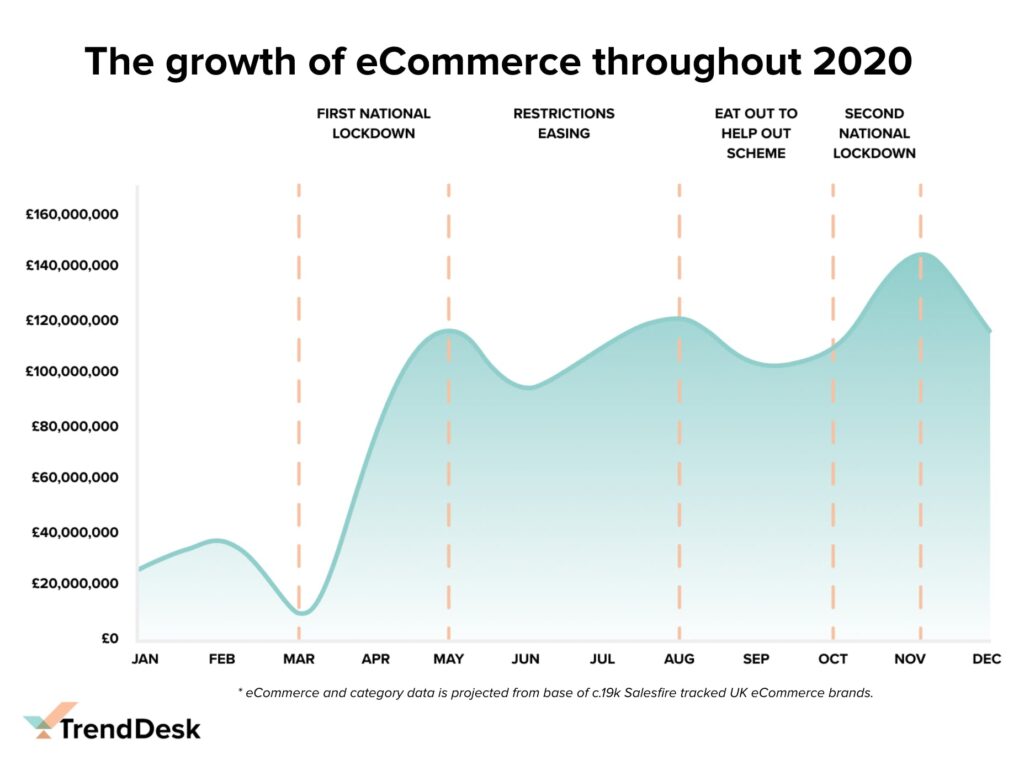
Josh: So what you’re seeing in front of you here is a top-line view of how eCommerce grew throughout 2020.
We’ve highlighted some of the key events socially for your reference, but it’s pretty clear to see how national lockdowns have propelled sales online and how the base level of a brand’s digital sales have been largely inflated Something we believe is almost certainly going to remain this way.
Following the orders to stay indoors at the end of March, total eCommerce revenue accelerated faster than any period ever since 2006. And that is literally when ONS records began. So I’ll hit you over at Calum now where we’re going to start our analysis.
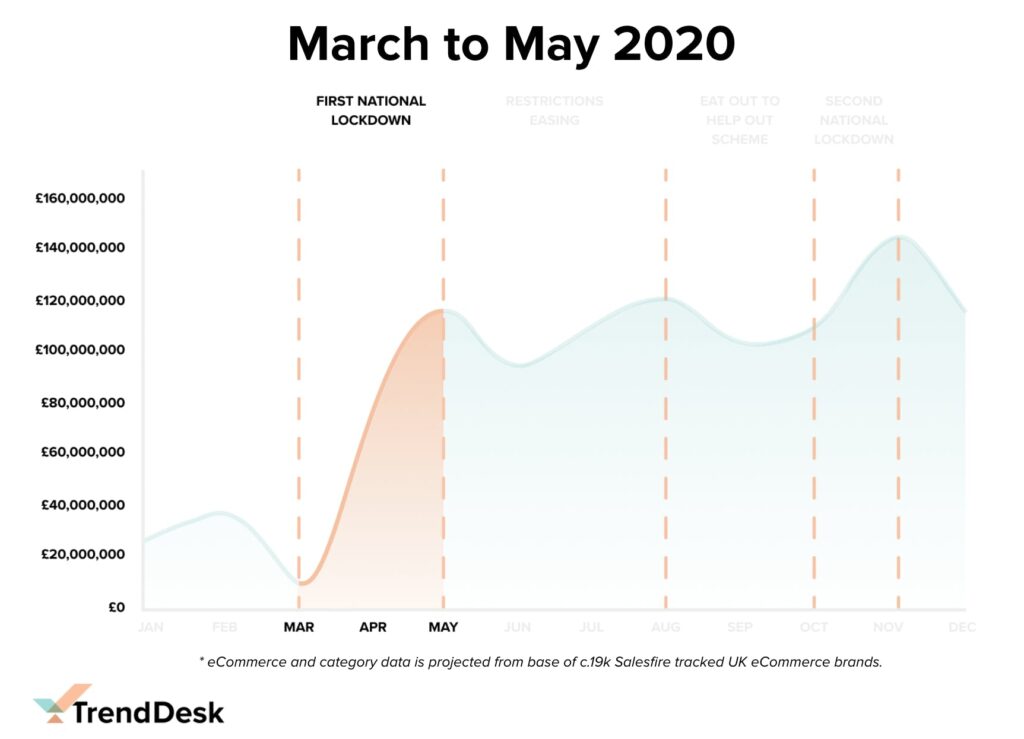
Calum: [00:05:53] Yeah. So as Josh mentioned, that was a crazy time for eCommerce and the natural place to start our analysis.
So, those months between March and May set the precedent for what was to come throughout 2020.
Personally here at Salesfire, we witnessed many clients’ online revenues in this time period grow between six and seven times in April than they had in March, which was a super crazy time to be in eCommerce and really outdoors of eComm that was where society was really starting to adjust to a life indoors.
So what we’ve tried to do here is understand that peak, but through the lens of different industries and we’ve selected three industries that reflected the main changes we were facing as a nation.
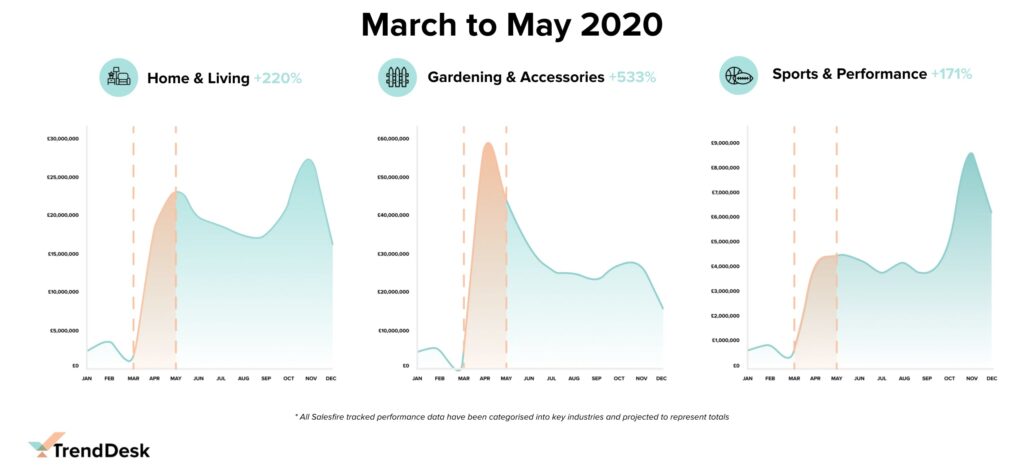
Calum: All of a sudden our work, our play and our health were all facing major alterations.
From a work perspective, the office-based population were forced to turn bedrooms, kitchens, and dining rooms into desks, meeting spaces and Zoom backgrounds.
This drove massive revenue growth at the time for the home and living industry, with a massive 220% of extra revenue spent in that home and living category in the three months ending May.
Josh: [00:07:23] Just in regards to trends, did we see anything particularly change at this point? Which were the key categories we really saw those trends being kickstarted in?
Calum: [00:07:31] Yeah, well, it kickstarted a massive kind of macro trend and really people starting to view their homes as more than just living spaces.
So we saw this outside of our own data with kind of DIY sales in companies like B&Q and Screwfix. They were recording hugely successful years for revenue.
And the main trend is as people start to filter that money they would initially have spent within travel or entertainment, they’ve started to push that towards other industries like home improvements for example.
Josh: [00:08:09] I suppose when you mentioned travel, that’s one that is also going to lead directly into hobbies as well. Isn’t it? On this next slide?
Calum: [00:08:14] Definitely, hobbies were massively impacted.
So the shutting down of leisure centres and social gatherings meant that much of the population took up kind of new and safe hobbies.
One of the major winning industries we saw was gardening and accessories. So this industry actually saw a massive, massive growth of 533% in those three months.
But it’s interesting to look at that chart because we can see that, although there was that massive engagement at the start, those inflated revenues didn’t really sustain. And that suggests that increased revenue, increased demand is not going to sustain post lockdown.
Josh: [00:08:59] We can sort of see that in sports and performance can’t we as well with that rise there?
Calum: [00:09:02] Yeah, definitely. That was another winning industry in those first few months, but different to gardening and accessories we see that performance sustained throughout the year and even spiked again in Q4.
So what we saw there was, with the closure of gyms and leisure centres, many people actually flocked to those kinds of sports apparel and equipment brands to supplement their health.
They knew if they were going to stay inside, then they needed to do something.
So we’ve had conversations here with those in charge of gym brands trying to suggest and saying that they might have to rethink their business models to suit that kind of consumer in a post-COVID world.
Josh: [00:09:53] Change that refocus? Yeah, that’s been something that we’ve had to deal with quite a bit, isn’t it?
And that leads us directly into May and August, I suppose, when things were getting a bit more comfortable. We started having a bit more of an idea of how sort of lockdown looks. And I dare say we sort of had eyes on how we started pulling out of it. And how we start seeing life reopen, albeit in a slightly more restricted way than what we’re used to.
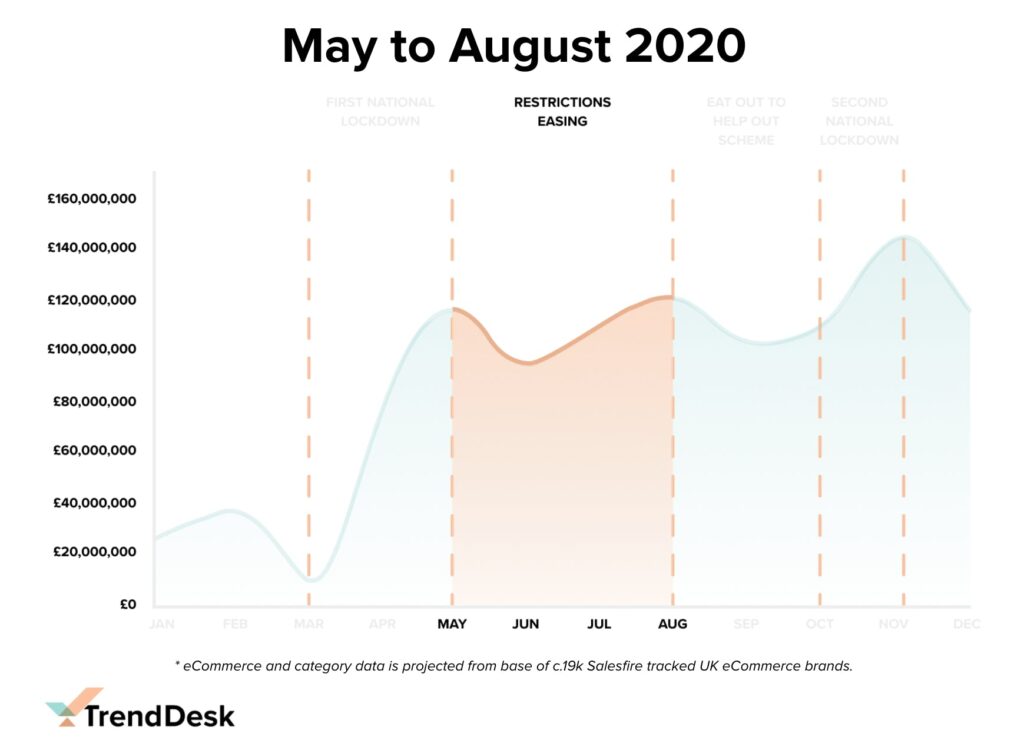
Calum: [00:10:21] Yeah if we’d said that the period before the market was very reactionary to what was going on.
I think it’s fair to say that the middle period between May and August was more about acceptance and a great reflector of this is lying in average order values.
So there were many categories that realised large growth in basket spend in this time period. And we’ve identified a few things that this is a combination of.
So one, a greater confidence in brands to fulfil those online orders. Two, a general acceptance, to lockdown and this is how life was going to be. And three, a burning desire to make that lockdown life more pleasurable.
And if we isolate health and beauty, for example, we see that and acceptance to the fact that salons and hairdressers weren’t going to open anytime soon.
So people not only spend on self-care but really invest in it and really spend extra money on a pair of straighteners for example, that are going to replicate that experience for them.
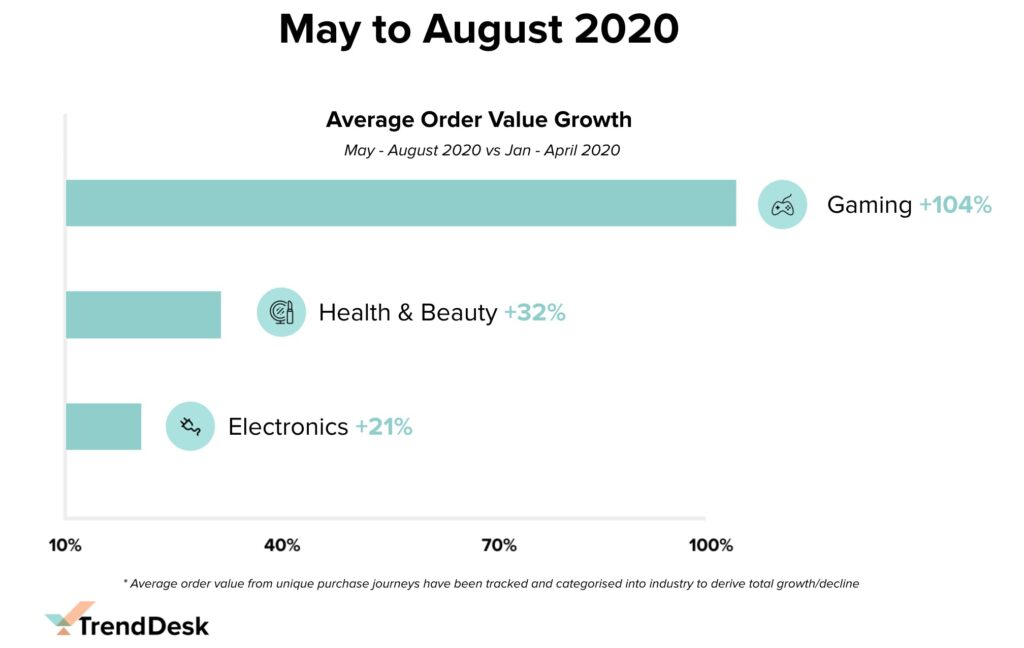
Josh: [00:11:31] DIY haircuts.
Calum: [00:11:32] DIY haircuts, definitely. And some of them definitely look better than others. And I’m the victim of that.
But other industries like gaming and electronics saw big, big rises in average order values.
And this revisits the trend of people re-budgeting money usually spent in entertainment and travel into things that would just make their day to day life more pleasurable.
Josh: [00:11:59] Is that something we’ve managed to sustain looking at the numbers? Or is that similar to gardening, where we saw that initial high that’s amazing but then we also saw that, not really a steady but quite a steep drop?
Calum: [00:12:12] Well yeah, that growth has sustained throughout the year and it’s something that we think will continue into 2021 and beyond.
Again, the factors of such an ease of online shopping and because brands are seeing this and reacting and making their online offerings much smoother.
That combined with still a bit of a perceived health risk of shopping in-store and bumping into people, for example, that’s going to bump up those order values and basket spends.
So if I’m a brand listening to this, I’m going to want to make sure that my average order values are growing in line with the industry.
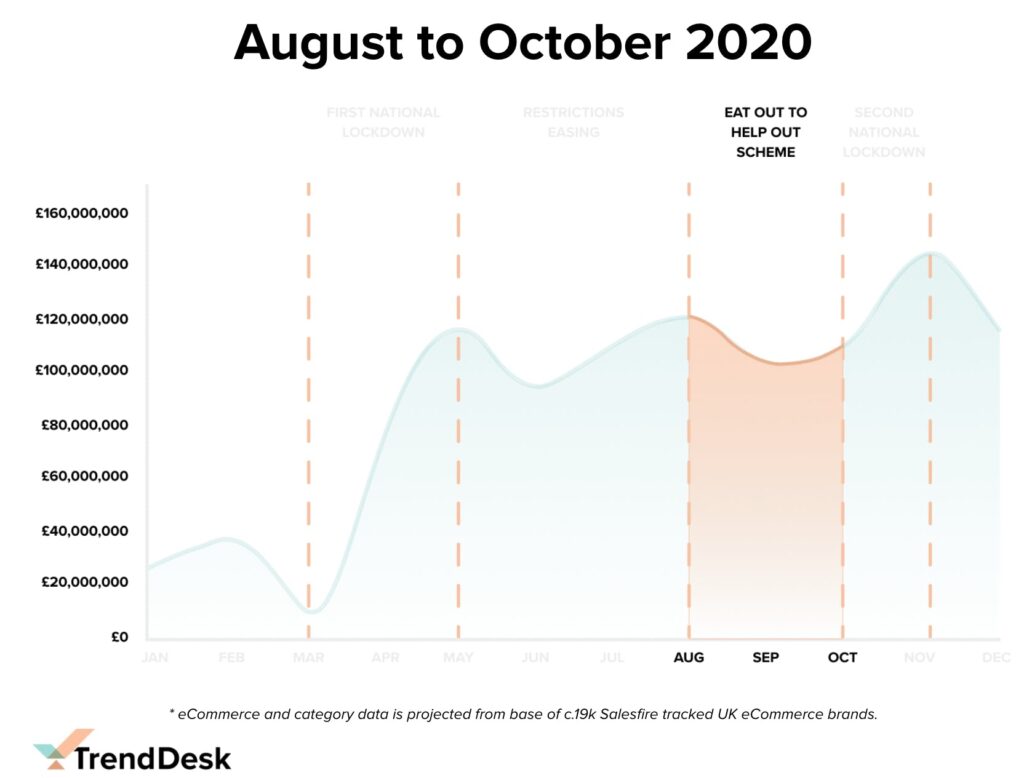
Josh: [00:12:52] This brings us onto August running through to October.
So we were starting to get out and about a bit more, albeit quite tentatively.
The most symbolic representation of this being the ‘eat out to help out’ scheme that was introduced, encouraging people back out into the open in an effort to revive the hospitality industry.
But how did that affect us online?
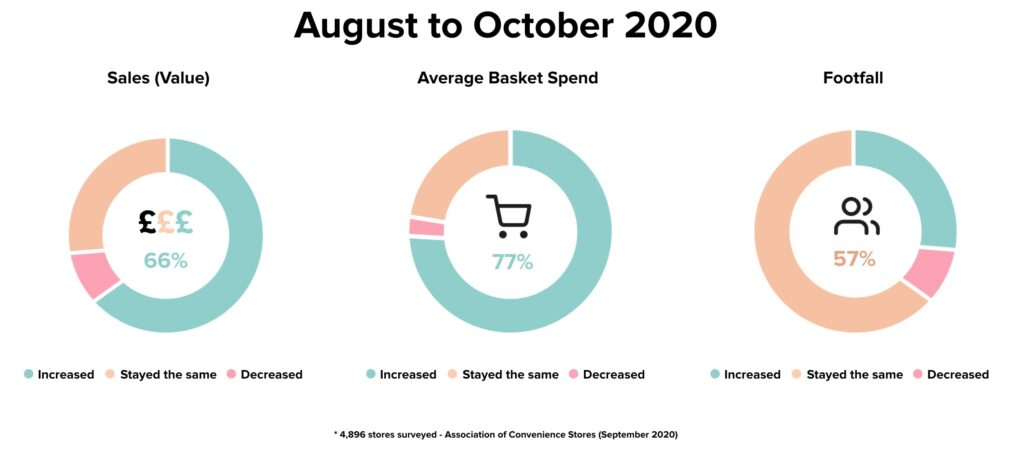
Calum: [00:13:17] Well Josh, here I’m going to actually move away from TrendDesk data and look at some data from the Association of Convenience Stores, which show that a drop in eCommerce spend was largely picked up by local and independent bricks and mortar.
So looking at those pie charts, we can see that as the population was encouraged to venture out, sales values increased and basket spending grew within those local and independent stores as people started to show a sense of a much kind of maligned community loyalty.
Josh: [00:13:54] This is an interesting one because this is something we’ve discussed previously on podcasts and the like. Do you think this is something that’s going to be of interest to people in 2021?
Calum: [00:14:06] Well, I think it’s too early to say, but it’s definitely an interesting trend to follow in 2021.
I think it can go one of two ways really.
If the vaccine is successful, we may actually see a proud return to the high street and a plateau to the immense eComm growth of 2020.
So it’s probably good to follow those brands with a multi-channel approach to see how they’re doing because they’ll benefit from being able to bring that sense of community loyalty back into their online offerings as well.
Josh: [00:14:43] Cool, makes sense. Especially with them being so niche and things like that as well, they tend to be the ones that come out the gate with the multi-channel hats on.
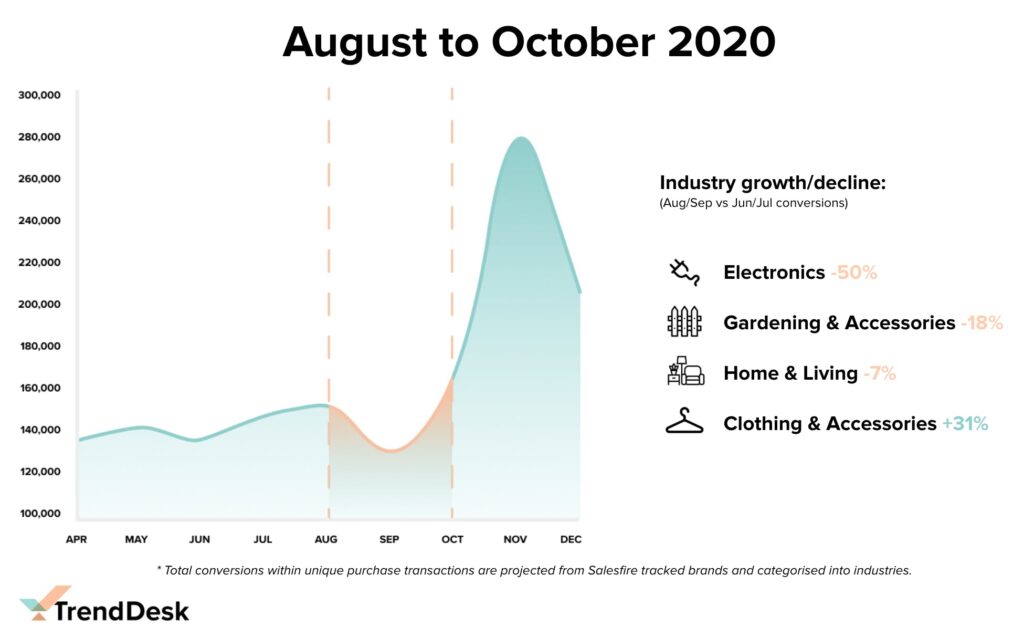
Calum: [00:14:50] Yeah and if we flip back to online, TrendDesk recorded a lull in what was a year of massive growth for online conversions between August and October.
So if you look at the chart there, then that’s actually the only period throughout the year that we see a defined drop in online purchasing then.
Josh: [00:15:13] Which sectors, in particular, do we have eyes on those?
Calum: [00:15:17] Yeah so the beauty of TrendDesk is that we can actually break it down by category and industry and some of the sectors that saw the biggest drops were electronics, gardening, and home.
And I think this is perhaps an indication of some of the types of products that consumers prefer to buy in-store, given the opportunity.
Now, this isn’t necessarily true for the clothing industry. And as you’ll see that the conversions actually grew by 31% in that time period.
So there’s definitely a distinction there, there are some products that consumers are quite happy to purchase online.
And then there are some products and industries that given the opportunity to go in-store, people will want to check out big-ticket electronics or, or see plants, for example, in the gardening industry up close.
Josh: [00:16:10] It’s interesting that as well with people being locked down, there’ll be, they’ll almost be craving that experiential hands-on trip to the Currys/PC world, to the Euronics Centre, that type of thing.
Calum: [00:16:22] So it is a really interesting one to follow how eCommerce adjusts to the return of high street shopping.
Josh: [00:16:31] It’s definitely one we’ll be following on TrendDesk as well, so it might be a good time to plug the newsletter.
We’re going to be sending out updates week on week, and we’ll probably be doing comparisons back to 2020 as well.
So October to November, we were looking to Christmas at this point and the potential easing of the lockdown. The idea there, that we might be able to see some of our loved ones and spend a bit of time getting merry.
At this point we were asking, are we actually going to end up braving the shopping centre on Christmas Eve, as I do? Or was I going to be doing it from an armchair?
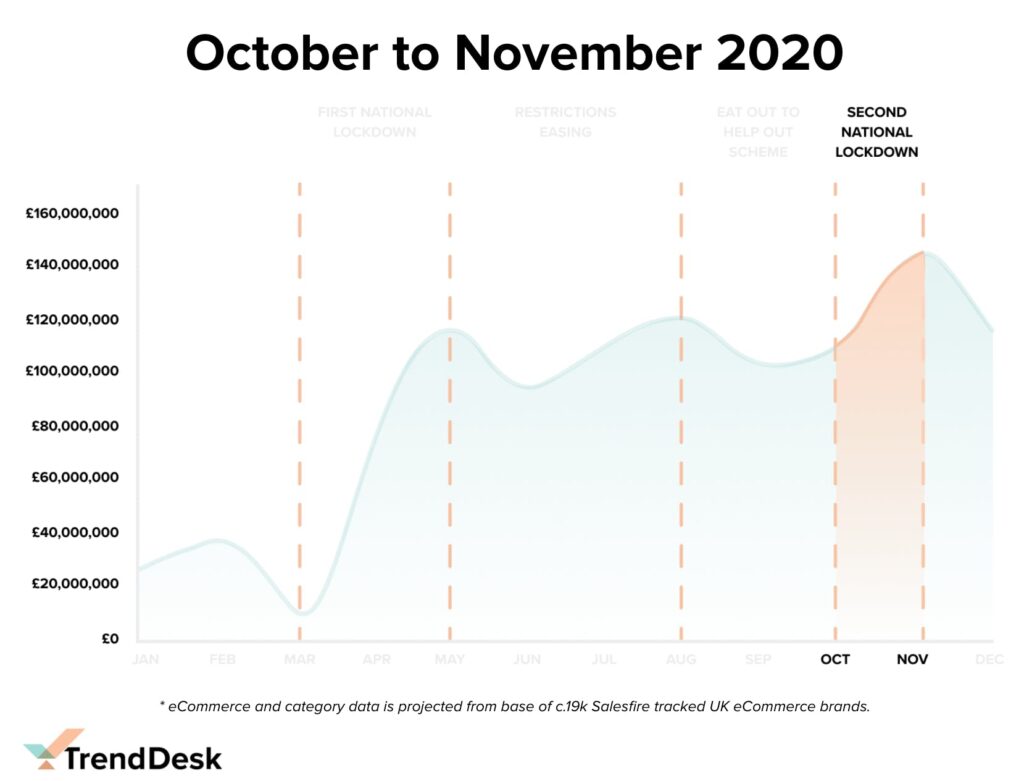
Calum: [00:17:06] Yeah so when we move into kind of the last section of our timeline, we’re going to focus on November, which was an extremely interesting month.
Now, November is usually a high month for consumer spend and you’ve got things like Black Friday and Cyber Monday, accelerating that.
But with another lockdown and with a kind of four-week circuit breaker, coming into effect on the 5th, then eCommerce experienced another massive boost to online sales.
Josh: [00:17:40] I think it’s important to note that this was a completely digitally exclusive Black Friday at this point. And we’ve also seen another boost in another significant event that I think you’ll be going into well.
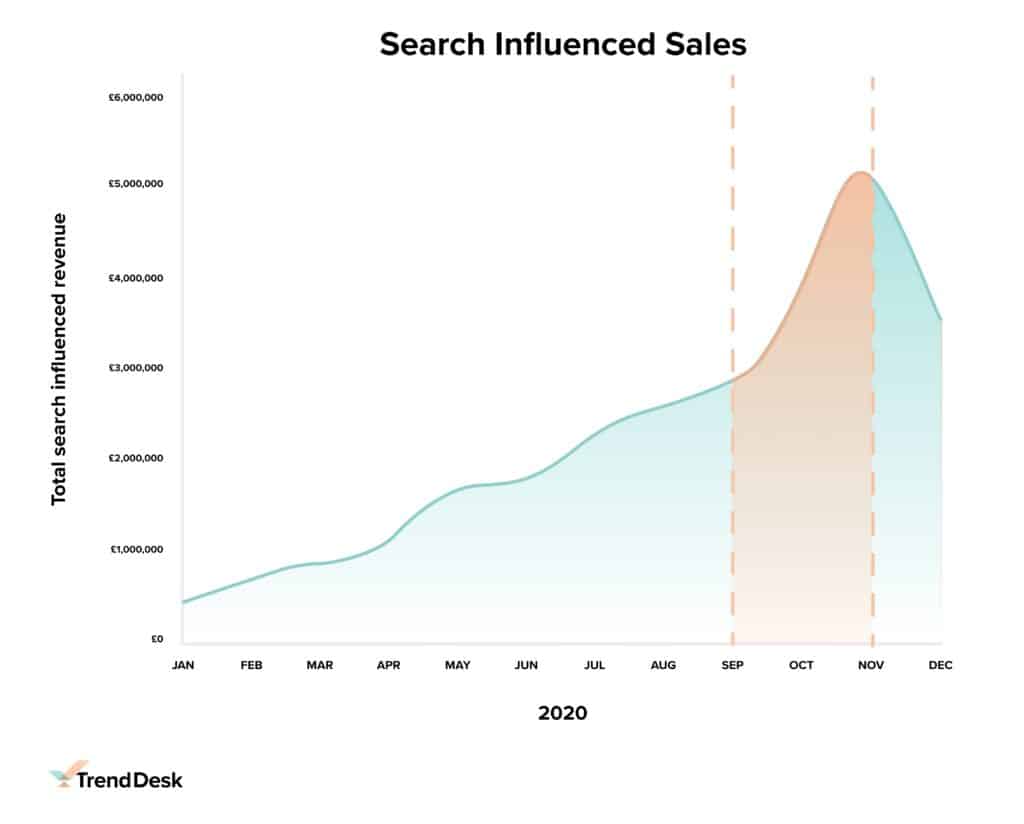
Calum: [00:17:57] One extremely interesting trend that we’ve been monitoring throughout the inception of TrendDesk is the consistent growth of Site Search as a big contributor to overall site revenue.
So as you can see on the chart throughout the year, consumer’s use of Site Search has been consistently growing, but in November, it peaked massively and sales driven through search channels were 90% higher than they were in September.
We believe that this explosion in Search will see it become the primary feature in the customer journey.
And we think it really needs to be exploited in 2021. And the way to do that is ensuring you have extremely fast and optimised Search capability on your eCommerce platform.
That’s kind of the one key thing that consumers will either be turned on or turned off, will be that site speed within searches.
Now to go back to revenue and to look at November by day, we can clearly identify some interesting things that are going on within the industry.
So Josh and I both think it’s really interesting in the home and clothing industries to see that drop in sales, a massive decline, the two days before Black Friday.
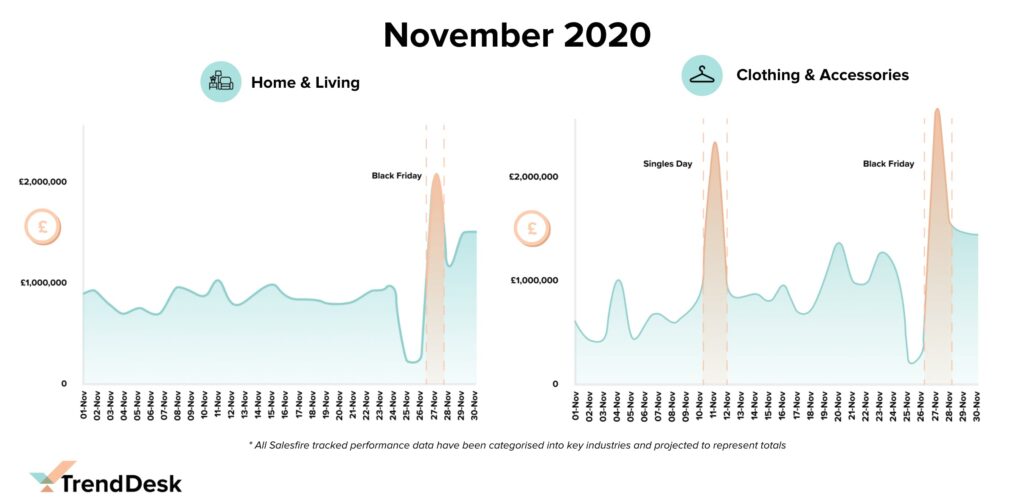
Josh: [00:19:27] It’s an interesting one that isn’t it?
We’ve seen a lot of huge retailers over the past few years completely put their site on ice, for lack of a better term, the day before Black Friday and just collect newsletter signups and grow that mailing list rather than let you shop on the entire site.
Which is obviously a way of saving resources for the rush for the next day.
And that obviously, again, as this data shows people are really stopping their spend and waiting for the potential sales the next day.
Calum: [00:19:58] Well the data is there now to back up the kind of things that people like JD are doing.
And things like marketing budget, paid media, isn’t really going to cut through on those two days before, so it’s really interesting to kind of see that and understand that for next year.
And then the second part of this chart, looking at clothing and accessories, it’s interesting to see a massive two-pronged peak within that month.
So things like Black Friday and Singles Day causing massive uplifts in demand within the clothing and accessories industry.
So this is something that we didn’t really foresee and weren’t massively prepared for at Salesfire, the massive demand that comes through the clothing industry on Singles Day. And we’re saying to all our clients within the sector, if this isn’t on your radar, then it really needs to be.
Josh: [00:21:02] Especially if you want to stay ahead.
Calum: [00:21:04] Well even in other industries, is Singles Day big for you?
Well, perhaps the data shows that home isn’t, but is there anything you can do to kind of piggyback on the demand of that event?
Josh: [00:21:17] From a strategic perspective, definitely.
Again, that’s something I know we’ve got quite a lot of existing clients signed up to this for us, so if you are interested in that to do with Singles Day or milking a bit more of your Black Friday and getting that a bit earlier, your account managers will be more than happy to run you through that too.
So we’re getting to the actionable bits, the bits that you’ve all really been waiting for. What are we got predicting in regards to the trends that are probably here to stay?
I’ll hand over to Calum for the first one that we’ve highlighted.
Calum: [00:21:50] So, as we’ve talked throughout the webinar, the whole trend of re-budgeting travel and entertainment spend is going to be massive for whatever industry you’re in.
There’s certainly a share of wallet out there and we don’t know how long these lockdowns are going to last, but every month that passes where we can’t travel out or we can’t visit bars, restaurants, theatre, etc. that budget is going to be spent in other industries.
So we’re going to look at which industries are really going to benefit from that and I think that’s something that all clients can take onboard.
Josh: [00:22:33] Another one we’ve mentioned here, brands’ base level of eCommerce sales are going to continue to grow.
I think it’s safe to say if you’re in eCommerce now you’ve probably made the right decision when it comes to any of your investments or business-related decisions.
The acceleration of which is going to depend on how people are marketing those, whether they’re successfully carving out their niche and how they’re interacting with various social channels, various paid channels, and making sure that their messaging is as clean as possible. And they’re finding their audience. Their audience isn’t out there looking for them and then not managing to be able to engage with them.
Calum: [00:23:14] I think a big trend to look at post-lockdown will be to see if once we come out of lockdowns if there is a modest drop in eCommerce revenues. And whether that spend goes back into the community and local independent stores.
Josh: [00:23:33] One we’ve certainly doubled down on when it comes to sort of putting our money where our mouth is, is on-site search, continuing to accelerate in being something that platforms really need to look at embracing and really lean to look at optimising.
It’s a key path to purchase for consumers and more often than not, it goes overlooked completely, whether it’s bad menus, whether it’s a bad layout.
It’s a point of contention now which is beyond question. It’s something that people really need to start taking seriously.
Again, it’s something we’re doing here and we’ll be more than happy to speak with you about that at some point after this as well.
Calum: [00:24:14] And if 2020 brought anything, it definitely brought a change in a consumer’s decision-making.
There’s heightened levels of anxiety everywhere and consumers now have to meddle with a lot of different thoughts before making a purchase, so brands that can adapt to this and promote flexibility onsite will see benefits to their conversion rates across the board.
Josh: [00:24:44] So this last one is one that we went out on a limb for in a podcast I think actually. We sort of got our predictions a little bit wrong.
I’ll put a link in afterwards so you can see us wrong live.
Singles Day next year is we believe is going to surpass Black Friday for the clothing and accessories industry.
It’s not going to be too tough for them to do I don’t think, I think there’s plenty of other sort of verticals that tend to do well on Black Friday.
For instance, if you are waiting for that pair of trainers, they’re probably not going to be going in the sale.
So we tend to see a lot of people not waiting for those more niche items but I think Singles Day is really going to be the one to watch next year.
Calum: [00:25:30] So as a recap, that was what happened in 2020, but what does the future of eCommerce look like?
And what’s the point in looking back if we’re not going to look forward? To keep it simple, we’ve outlined the two most critical ways to ride the wave of consumer behaviour in 2021.
Josh: [00:25:51] So what’s the first one?
Calum: [00:25:53] So there’s going to be a new evolution in Search, almost Darwinian.
As we’ve discussed, there’s unprecedented growth as a revenue driver Search was throughout 2020.
And the chart on the right also shows that page views are consistently growing across the board.
So this is going to be more traffic on websites and more of that traffic will be clambering to use Search as their main way of purchasing within that brand.
So with this being the case, anything less than an incredible optimised search function, which is super fast and adapts to everything that the consumer comes to expect, isn’t going to be sufficient.
Consumers now want to be able to search in seconds.
They want to be able to use Voice Search, like Siri or Alexa.
They want to be able to snap pictures they’ve seen before or find Visually Similar products than the ones they’ve seen in front of them.
So things like speed, flexibility and convenience within Search functions are going to be the main reason or the main thing you can do to improve conversion and retention rates next year.
And finally, brands are going to need to start to stretch like yoga instructors.
As we’ve mentioned with consumers in 2020, there’s been a lot of uncertainty and it’s fair to say that there’s been a lot more anxiety within everyone and how we make those purchase decisions.
So brands that can empathise with that and can adapt to those more concerned customers will succeed in 2021.
If a consumer wants to know more about delivery information, whether they can collect in-store or how long it will take to come, whether it’s the return process, what is that, or is there a different way of breaking up purchases to ease with that kind of financial worry?
If a brand can feed them all that information in one place then that will really help to improve and ensure that that traffic doesn’t leave to competitors and converts within the site.
Josh: [00:28:25] I think that about wraps us up. So thanks Calum.
If you did want to find out any more about optimising your search capabilities or promoting any of that flexibility throughout your eComm, platform, or your site specifically, we’d be more than happy to speak to you after this or put you in touch with one of our consultants.
And we will be following up with some cheat sheets in regards to stats and things like that afterwards, so you’ve got them to hand.
So thank you so much for listening to this point and thanks Calum for putting all that together. There’s a lot there and we will be sharing these slides as well.
Thanks for joining us and thanks for making it right through to the end.
We hope you enjoyed our first TrendDesk webinar.
Why not download our 2021 checklist to make sure your site is ready to maximise sales in the coming year.
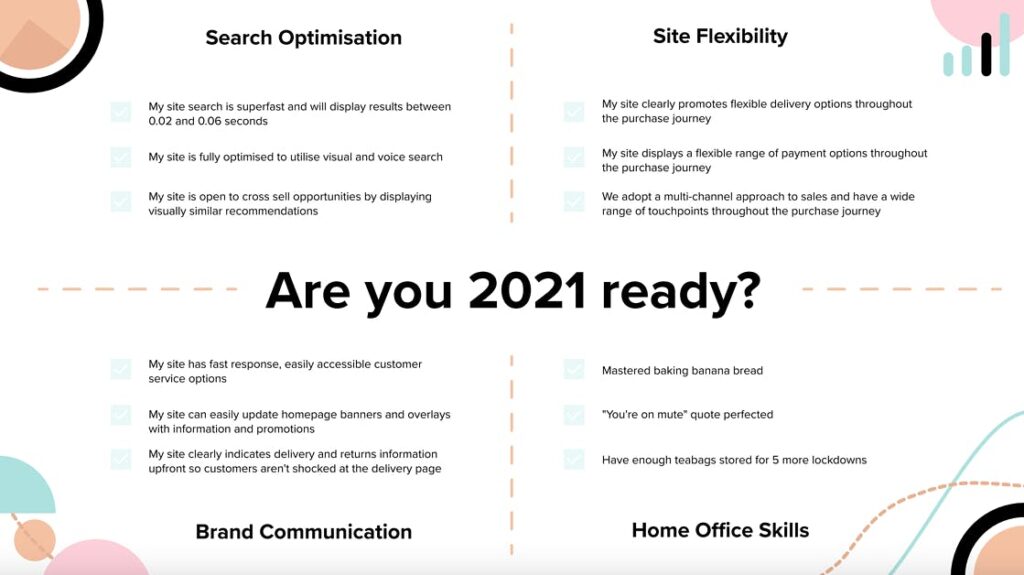
See how Salesfire can help you optimise your product discovery experience, email one of our experts at [email protected] or book a free demo of our personalisation tools.


